2018 河北考研英语一真题及答案
Section I Use of English
Directions:
Read the following text. Choose the best word (s) for each numbered blank and mark
A, B, C or D on the ANSWER SHEET. (10 points)
Trust is a tricky business. On the one hand, it's a necessary condition
1
many
worthwhile things: child care, friendships, etc. On the other hand, putting
your 2
, in the wrong place often carries a high
3
.
4
, why do we trust at all? Well, because it feels good.
5
people place their
trust in an individual or an institution, their brains release oxytocin, a hormone
that 6
pleasurable feelings and triggers the herding instruct that prompts humans
to
7
with one another. Scientists have found that exposure
8
this hormone puts
us in a trusting
9
: In a Swiss study, researchers sprayed oxytocin into the noses
of half the subjects; those subjects were ready to lend significantly higher amounts
of money to strangers than were their
10
who inhaled something else.
11
for us, we also have a sixth sense for dishonesty that may
12
us. A Canadian
study found that children as young as 14 months can differentiate
13
a credible
person and a dishonest one. Sixty toddlers were each
14
to an adult tester holding
a plastic container. The tester would ask, “What’s in here?” before looking into
the container, smiling, and exclaiming, “Wow!” Each subject was then invited to
�
look 15
.Half of them found a toy; the other half
16
the container was empty-and
realized the tester had
17
them.
Among the children who had not been tricked, the majority were
18
to cooperate
with the tester in learning a new skill, demonstrating that they trusted his
leadership.19
, only five of the 30 children paired with the “ 20 ”tester
participated in a follow-up activity.8694
1. [A] on [B] like [C] for [D] from
2. [A] faith [B] concern [C] attention [D] interest
3. [A] benefit [B] debt [C] hope [D] price
4. [A] Therefore [B] Then [C] Instead [D] Again
5. [A]Until [B] Unless [C] Although [D] When
6. [A] selects [B] produces [C] applies [D] maintains
7. [A] consult [B] compete [C] connect [D] compare
8. [A] at [B] by [C]of [D]to
9. [A] context [B] mood [C] period [D] circle
10.[A] counterparts [B] substitutes [C] colleagues [D]supporters
11.[A] Funny [B] Lucky [C] Odd [D] Ironic
�
12.[A] monitor [B] protect [C] surprise [D] delight
13.[A] between [B] within [C] toward [D] over
14.[A] transferred [B] added [C] introduced [D] entrusted
15.[A] out [B] back [C] around [D] inside
16.[A] discovered [B] proved [C] insisted [D] .remembered
17.[A] betrayed [B]wronged [C] fooled [D] mocked
18.[A] forced [B] willing [C] hesitant [D] entitled
19.[A] In contrast [B] As a result [C] On the whole [D] For instance
20.[A] inflexible [B] incapable [C] unreliable [D] unsuitable
Section II Reading Comprehension
Part A
Directions:
Read the following four texts. Answer the questions below each text by choosing A,
B, C or D. Mark your answers on the ANSWER SHEET. (40 points)
Text 1
�
Among the annoying challenges facing the middle class is one that will probably go
unmentioned in the next presidential campaign: What happens when the robots come
for their jobs?
Don't dismiss that possibility entirely. About half of U.S. jobs are at high risk
of being automated, according to a University of Oxford study, with the middle class
disproportionately squeezed. Lower-income jobs like gardening or day care don't
appeal to robots. But many middle-class occupations-trucking, financial advice,
software engineering — have aroused their interest, or soon will. The rich own the
robots, so they will be fine.
This isn't to be alarmist. Optimists point out that technological upheaval has
benefited workers in the past. The Industrial Revolution didn't go so well for
Luddites whose jobs were displaced by mechanized looms, but it eventually raised
living standards and created more jobs than it destroyed. Likewise, automation
should eventually boost productivity, stimulate demand by driving down prices, and
free workers from hard, boring work. But in the medium term, middle-class workers
may need a lot of help adjusting.
The first step, as Erik Brynjolfsson and Andrew McAfee argue in The Second Machine
Age, should be rethinking education and job training. Curriculums —from grammar
school to college- should evolve to focus less on memorizing facts and more on
creativity and complex communication. Vocational schools should do a better job of
fostering problem-solving skills and helping students work alongside robots. Online
education can supplement the traditional kind. It could make extra training and
�
instruction affordable. Professionals trying to acquire new skills will be able to
do so without going into debt.
The challenge of coping with automation underlines the need for the U.S. to revive
its fading business dynamism: Starting new companies must be made easier. In previous
eras of drastic technological change, entrepreneurs smoothed the transition by
dreaming up ways to combine labor and machines. The best uses of 3D printers and
virtual reality haven't been invented yet. The U.S. needs the new companies that
will invent them.
Finally, because automation threatens to widen the gap between capital income and
labor income, taxes and the safety net will have to be rethought. Taxes on low-wage
labor need to be cut, and wage subsidies such as the earned income tax credit should
be expanded: This would boost incomes, encourage work, reward companies for job
creation, and reduce inequality.
Technology will improve society in ways big and small over the next few years, yet
this will be little comfort to those who find their lives and careers upended by
automation. Destroying the machines that are coming for our jobs would be nuts. But
policies to help workers adapt will be indispensable.
21.Who will be most threatened by automation?
[A] Leading politicians.
[B]Low-wage laborers.
�
[C]Robot owners.
[D]Middle-class workers.
22 .Which of the following best represent the author’s view?
[A] Worries about automation are in fact groundless.
[B]Optimists' opinions on new tech find little support.
[C]Issues arising from automation need to be tackled
[D]Negative consequences of new tech can be avoided
23.Education in the age of automation should put more emphasis on
[A] creative potential. [B]job-hunting skills. [C]individual needs. [D]cooperative
spirit.
24.The author suggests that tax policies be aimed at
[A]encouraging the development of automation.
[B]increasing the return on capital investment.
[C]easing the hostility between rich and poor.
[D]preventing the income gap from widening.
25.In this text, the author presents a problem with
�
[A] opposing views on it. [B]possible solutions to it. [C]its alarming impacts.
[D]its major variations.
Text 2
A new survey by Harvard University finds more than two-thirds of young Americans
disapprove of President Trump’s use of Twitter. The implication is that Millennials
prefer news from the White House to be filtered through other source, Not a president’
s social media platform.
Most Americans rely on social media to check daily headlines. Yet as distrust has
risen toward all media, people may be starting to beef up their media literacy skills.
Such a trend is badly needed. During the 2016 presidential campaign, nearly a quarter
of web content shared by Twitter users in the politically critical state of Michigan
was fake news, according to the University of Oxford. And a survey conducted for
BuzzFeed News found 44 percent of Facebook users rarely or never trust news from
the media giant.
Young people who are digital natives are indeed becoming more skillful at separating
fact from fiction in cyberspace. A Knight Foundation focus-group survey of young
people between ages 14and24 found they use “distributed trust” to verify stories.
They cross-check sources and prefer news from different perspectives—especially
those that are open about any bias.“Many young people assume a great deal of personal
responsibility for educating themselves and actively seeking out opposing
viewpoints,” the survey concluded.
�
Such active research can have another effect. A 2014 survey conducted in Australia,
Britain, and the United States by the University of Wisconsin-Madison found that
young people’s reliance on social media led to greater political engagement.
Social media allows users to experience news events more intimately and immediately
while also permitting them to re-share news as a projection of their values and
interests. This forces users to be more conscious of their role in passing along
information. A survey by Barna research group found the top reason given by Americans
for the fake news phenomenon is “reader error,” more so than made-up stories or
factual mistakes in reporting. About a third say the problem of fake news lies in
“misinterpretation or exaggeration of actual news”via social media. In other words,
the choice to share news on social media may be the heart of the issue. “This
indicates there is a real personal responsibility in counteracting this problem,”
says Roxanne Stone, editor in chief at Barna Group.
So when young people are critical of an over-tweeting president, they reveal a mental
discipline in thinking skills – and in their choices on when to share on social
media.
26. According to the Paragraphs 1 and 2, many young Americans cast doubts on
[A] the justification of the news-filtering practice.
[B] people’s preference for social media platforms.
[C] the administrations ability to handle information.
�
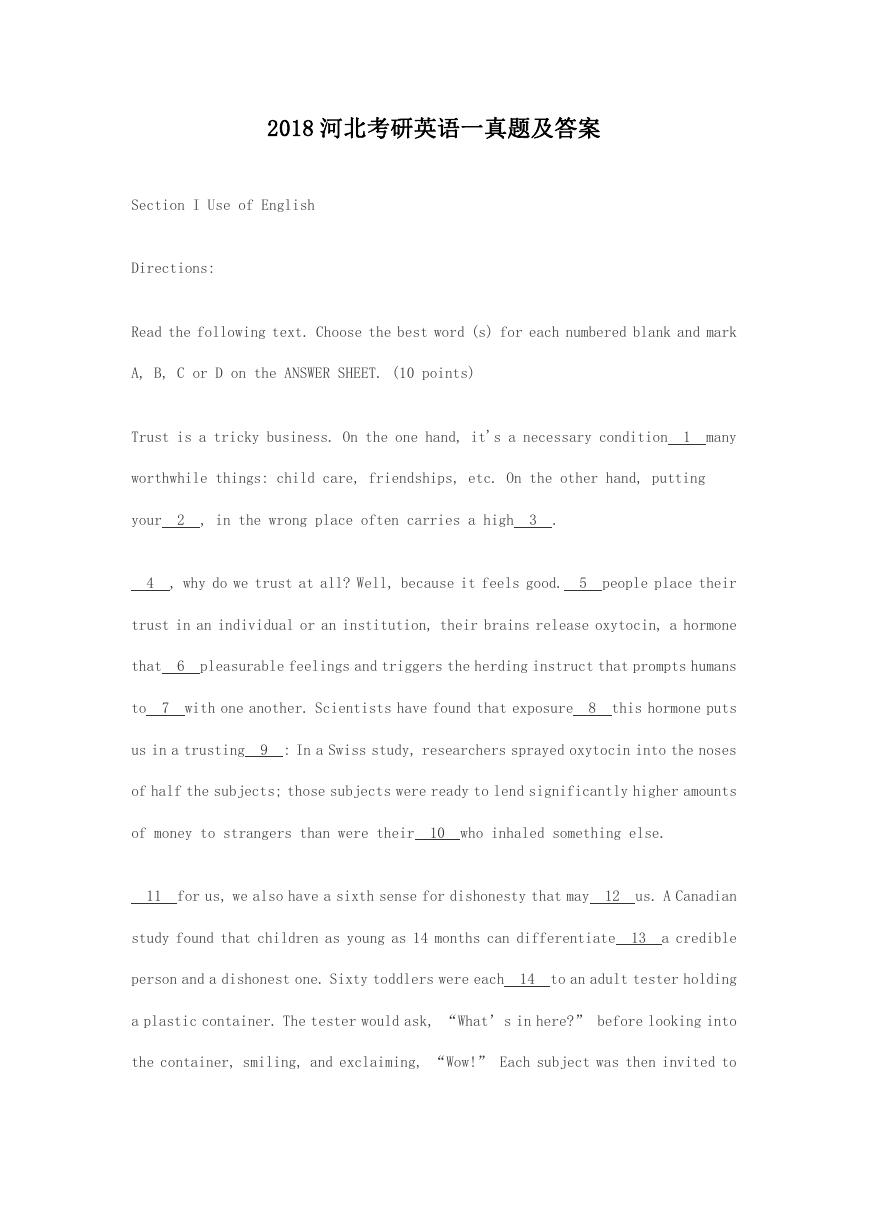
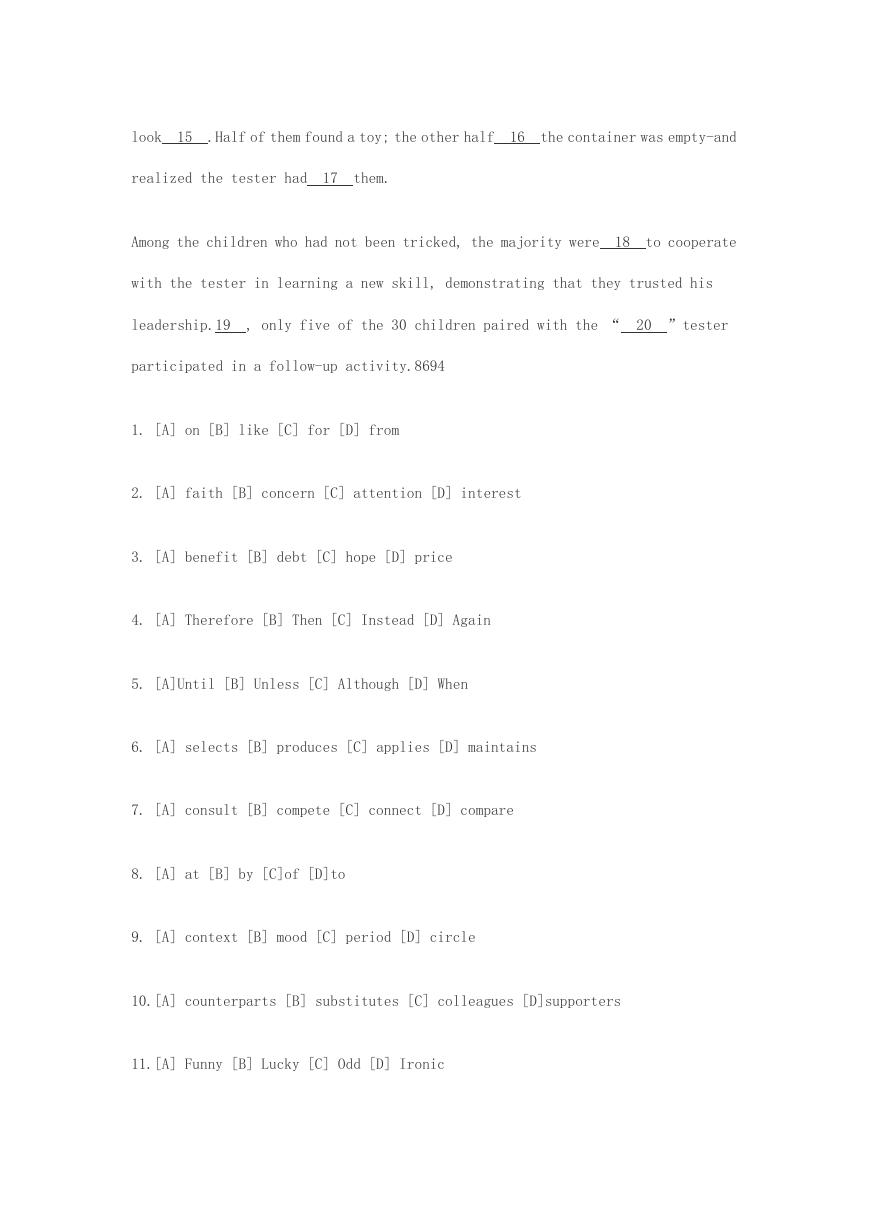

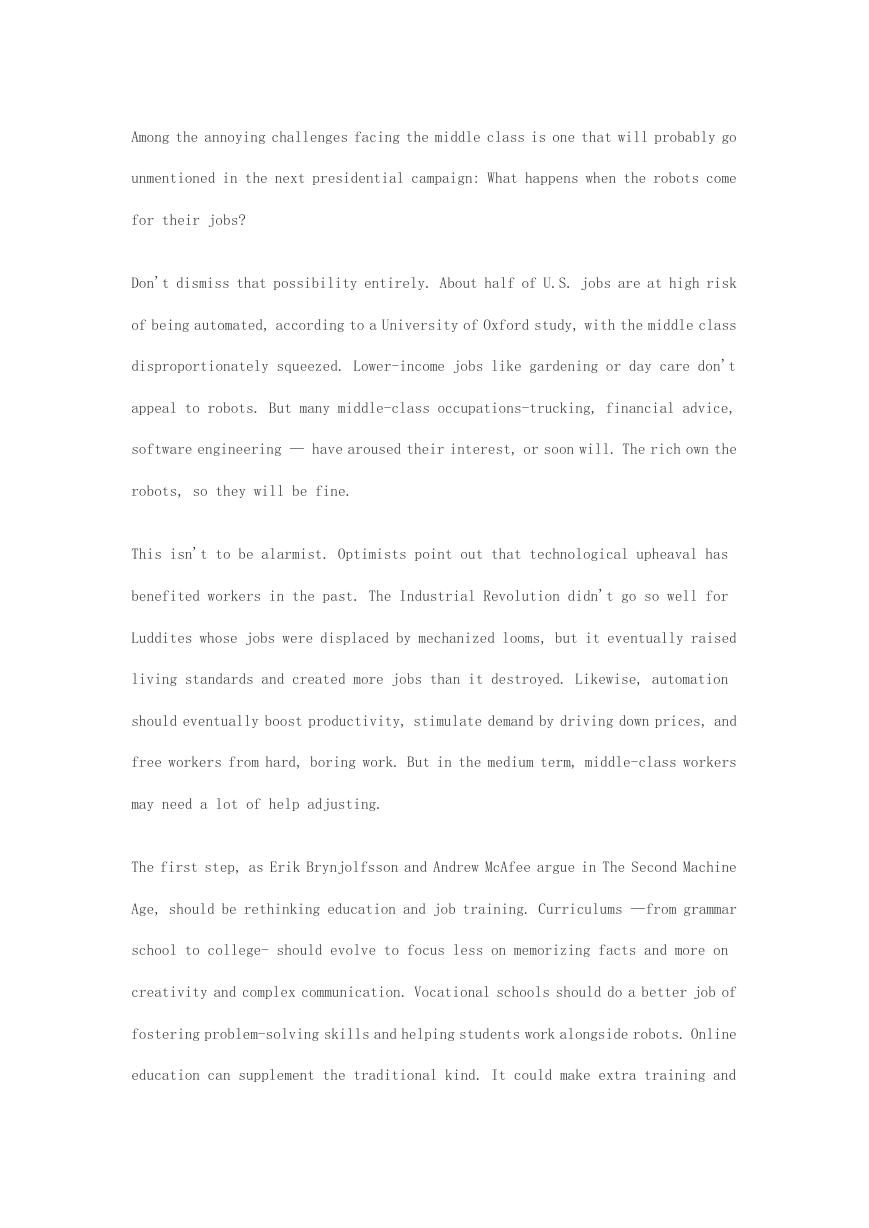
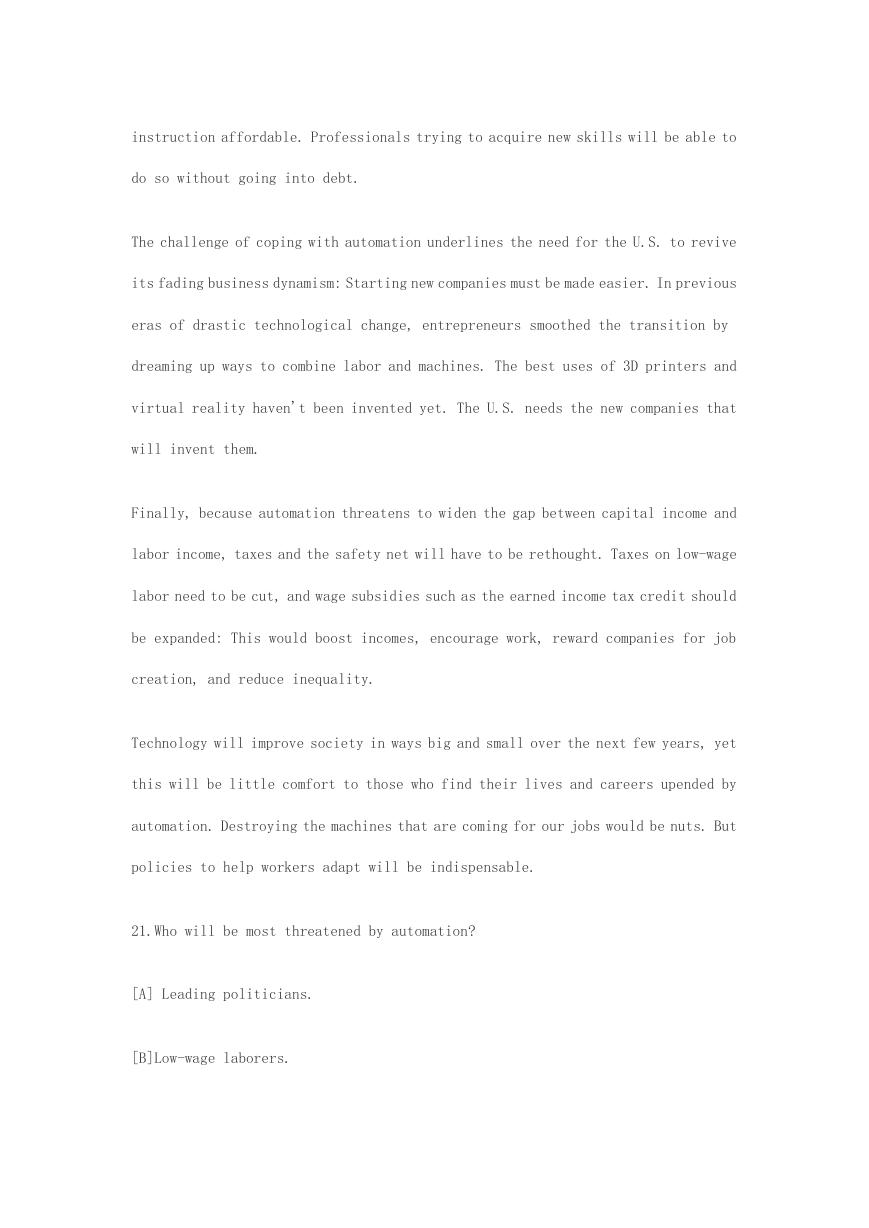
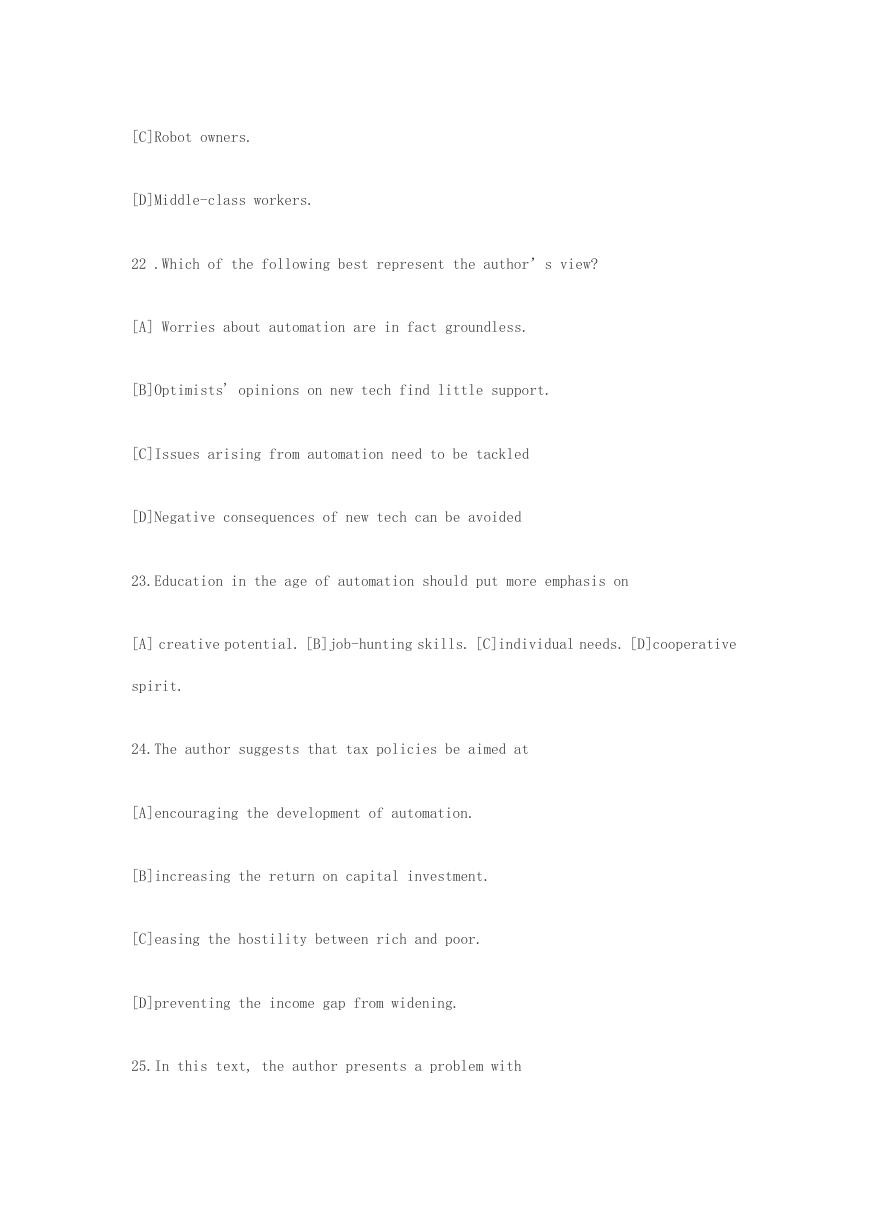
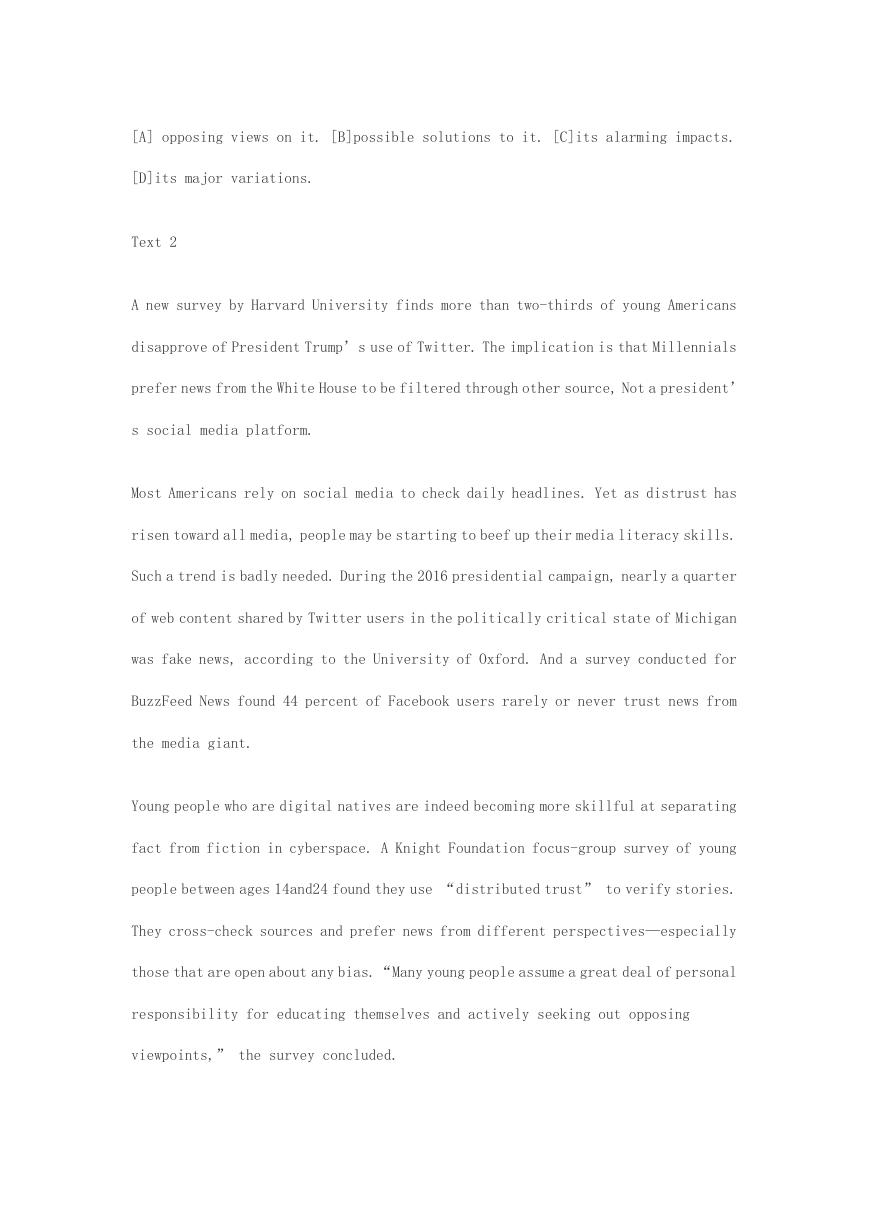
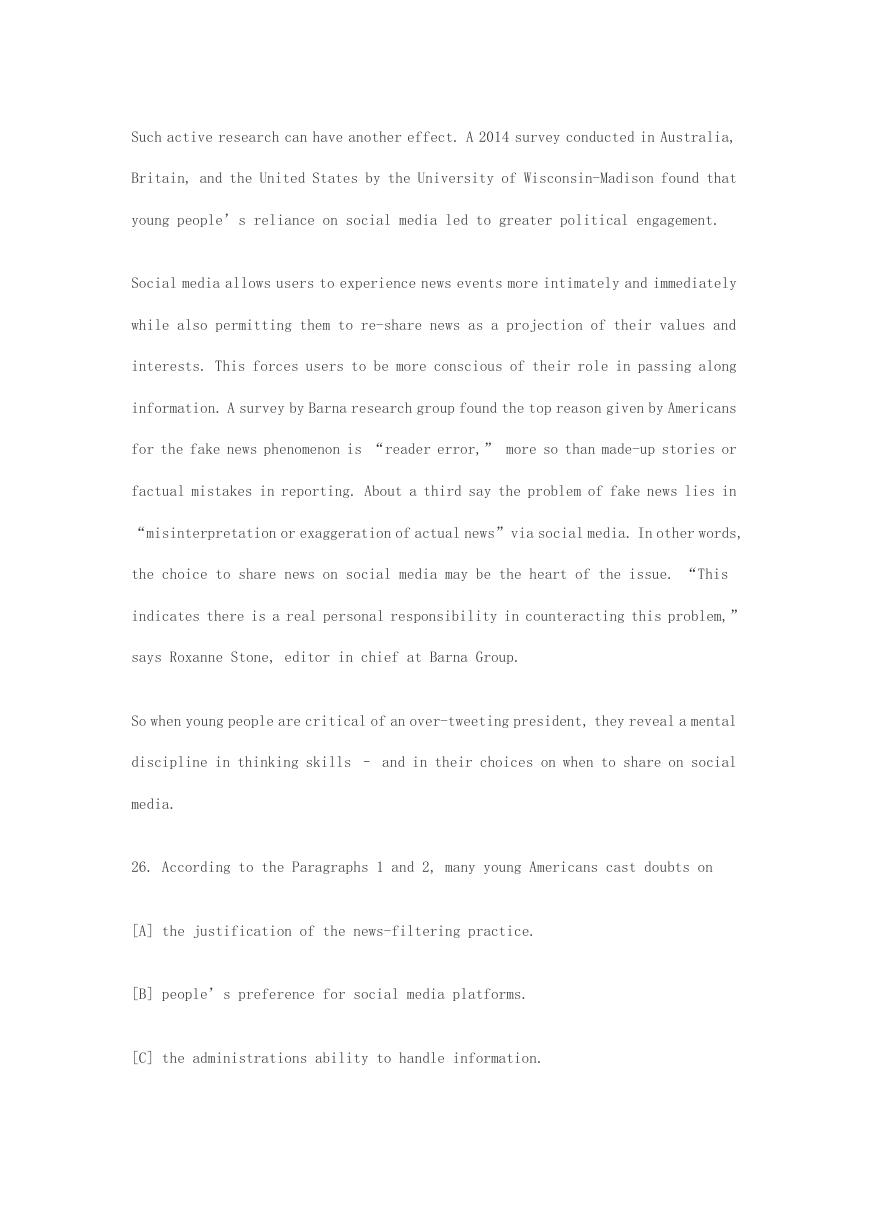








 2023年江西萍乡中考道德与法治真题及答案.doc
2023年江西萍乡中考道德与法治真题及答案.doc 2012年重庆南川中考生物真题及答案.doc
2012年重庆南川中考生物真题及答案.doc 2013年江西师范大学地理学综合及文艺理论基础考研真题.doc
2013年江西师范大学地理学综合及文艺理论基础考研真题.doc 2020年四川甘孜小升初语文真题及答案I卷.doc
2020年四川甘孜小升初语文真题及答案I卷.doc 2020年注册岩土工程师专业基础考试真题及答案.doc
2020年注册岩土工程师专业基础考试真题及答案.doc 2023-2024学年福建省厦门市九年级上学期数学月考试题及答案.doc
2023-2024学年福建省厦门市九年级上学期数学月考试题及答案.doc 2021-2022学年辽宁省沈阳市大东区九年级上学期语文期末试题及答案.doc
2021-2022学年辽宁省沈阳市大东区九年级上学期语文期末试题及答案.doc 2022-2023学年北京东城区初三第一学期物理期末试卷及答案.doc
2022-2023学年北京东城区初三第一学期物理期末试卷及答案.doc 2018上半年江西教师资格初中地理学科知识与教学能力真题及答案.doc
2018上半年江西教师资格初中地理学科知识与教学能力真题及答案.doc 2012年河北国家公务员申论考试真题及答案-省级.doc
2012年河北国家公务员申论考试真题及答案-省级.doc 2020-2021学年江苏省扬州市江都区邵樊片九年级上学期数学第一次质量检测试题及答案.doc
2020-2021学年江苏省扬州市江都区邵樊片九年级上学期数学第一次质量检测试题及答案.doc 2022下半年黑龙江教师资格证中学综合素质真题及答案.doc
2022下半年黑龙江教师资格证中学综合素质真题及答案.doc